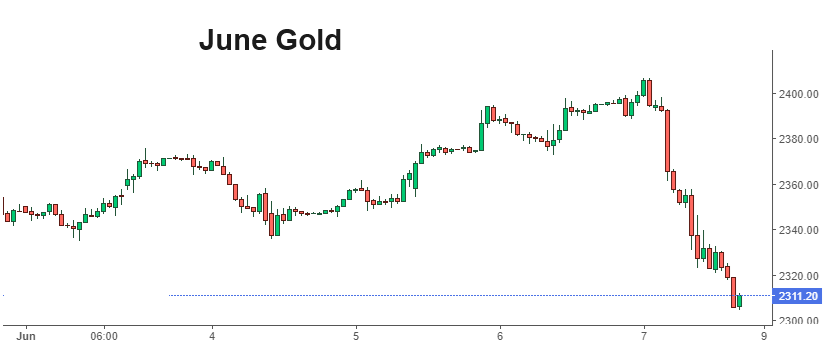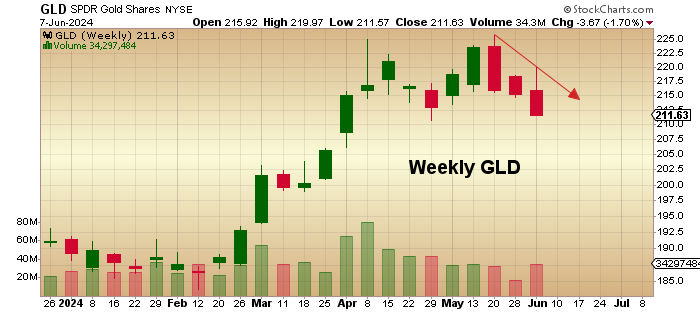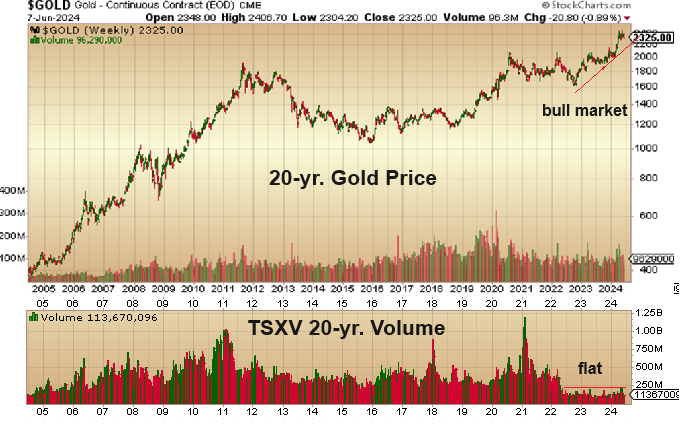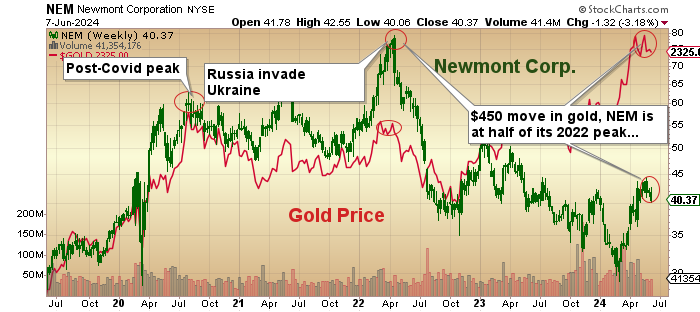It was only seven days ago, when I sat down to write the weekly missive, that I found myself faced with a dilemma. I know that many of my subscribers, followers, and friends like to read my thoughts on the precious metals markets because although the service is called "The GGM Advisory" (implying a vague reference to some product or service called "GGM"), the name is the offspring of a weekly letter that I used to send to my clients when I was employed in the investment industry that was called "Gold and Gold Miners."
I changed the name in 2013 after the infamous and highly criminal bullion bank raid on the metals, later called "The Sunday Night Massacre," during which time the banking fraternity eviscerated the gold and silver markets between the hours of 9:00 pm and 6:00 am while the major Western gold traders were all sound asleep. I was so thoroughly disgusted with the blatancy of criminality in that action that I swore I would never allow my career to be dependent on any one single asset class that could be "managed" in the total absence of "true price discovery" only reachable in the free market venue of the trading pit.
However, I later learned that thanks largely to the superb efforts of Bill Murphy and Chris Powell of The Gold Anti-Trust Action Committee, the precious metals markets are considered "public enemies" of the state. (Bill's excellent newsletter can be accessed here.)
So, I changed the name of the letter in order to allow coverage of other asset classes not on the "public enemy" list, which includes virtually everything traded on either the London Metals Exchange or the U.S. Comex deemed to represent no challenge to the authority or ascendancy of the sacred U.S. dollar. To this day, I have no knowledge of exactly which department of the American government has the authority and mandate to monitor and "manage" gold and silver prices, but it is most certainly under the purview of the Working Group on Financial Markets signed into law under Executive Order 12631 on March 18, 1988, in response to the devastation caused by the October 19, 1987 market crash.
What was originally a four-man committee evolved demonically into an institutional behemoth with direct authority over hundreds of traders at banks and other institutions, including the New York Fed and the major money-center banks. No longer would stocks be allowed to crash in the interest of "national security," and no better example of its urgency than 14 years later, when investigations of the 9/11 terrorist attacks on the World Trade Center revealed aggressive and highly suspicious shorting activity of the major American airlines in the days leading up to the disaster.
I am constantly staring into the mirror, asking myself why on earth anyone with half a brain would venture into the world of stock market analysis with the knowledge that there is an entity out there with unlimited liquidity supporting stocks at all hours of the night and day while thwarting any attempts by sound money advocates to find monetary safe haven from government promiscuity (i.e., "gold and silver").
In a direct challenge to Albert Einstein's famous definition of insanity, I used to buy all technical breakouts in gold and silver on the mistaken assumption that "this time it will be different," resulting in a repeat of the 1976-1980 period of gold market rapture that saw blue-chip, non-resource stocks crater while the resource stocks exploded higher, led, of course, by the gold stocks but indeed bested in the final stretch by the silver stocks whose price advance made Nvidia Corp. (NVDA:NASDAQ) look like Bell Telephone.
Up until that fateful Sunday evening in 2013 when the global bullion banks made a mockery of free market capitalism and unimpeded price discovery, I was happy to call my newsletter "Gold and Gold Miners" but after that, "repeating the same behaviours over and over and over again only to achieve the same negative outcome" became a thing of the past. I changed the name of my newsletter and proceeded to think and act and TRADE like a bullion bank. It was truly a "Eureka!" moment.
Since I made the move, my results have been markedly improved but by no means perfect, and the reason is that the omnipotent power of the American government with respect to global finance is a mere shadow of what it once was. No longer can the whims of a cranky campaign manager pick up the "red phone" and order gold down $100/ounce at 3:00 am New York time because there is a megalodon carcharodon out there swallowing up vast amounts of gold and silver ounces with little or no consideration of the plans or preferences of the U.S. government. That creature hunts in waters in the East and is rapidly attracting other large predators with no concern (or fear) of the Western gold price managers.
As I write this note, I must tell you that with many dutiful followers who only read my weekly missives, they think that my only actions in the gold and silver markets are of a bullish bent, constantly spewing out narratives that would have me a perpetual Sprott-like or Schiff-like "BUY-BUY-BUYER" of gold at all times and without repenting. Unfortunately, that is not exactly true. Last week, I wrote this and included a graphic of an ancient exorcism from the 1300's.
"In case you are all cringing in horror, let it be said that there is nothing sacrilegious about being a gold bull while trading a near-term short position. The big traders I have known over the years care not about the fundamental case for any security; they care only about price and direction. Right now, the SPDR Gold Shares ETF (GLD:NYSE) looks to be vulnerable to a major shakeout. My choices are to sit and wait until it completes the cycle or try to make a few shekels off it. I choose the latter, and that does not imply that I am the victim of demonic possession in need of Father Karras."
I went into the beginning of last week short a modest position in GLD but by Wednesday, I was chest-deep in a world of hurt, bleeding from every open orifice on my septuagenarian body. Every synapse of technical analysis memory had been put to use to justify and rationalize a short position in gold, and had it not been for my "cat-on-a-hot-stove" recall, I would have shorted the daylights out of silver as well because the vast legions of fuzzy-cheeked lithium podcasters that made the pivot last January to become uranium podcasters all collectively (and predictively) made that fateful pivot last month to silver! I kept scanning the Market Watch feed to see a plethora of TSXV juniors announcing name changes from "battery metals" to "silver" in order to secure the support of someone — anyone — with the ability or desire to inject money into their sorry treasuries sufficient to meet "general working capital requirements" for at least the next quarter (i.e., salaries). However, as always, I digress.
I wrote to subscribers this morning that I had endured a most fitful night after having studied all of my gold charts until almost midnight. Thursday at midnight, I was looking at a really big losing position in the GLD:NYSE put options, and I was noticeably upset with myself because here I was — aligned with the same negative positioning as those evil bullion banks wondering as I was pulling large chunks of hair from my scalp why those always-reliable heathens had failed me this time.
For the GLD, all the technical signals upon which I had relied faithfully since 2013 had abandoned me. I had two weeks until expiry, and I had given up 65% of my capital in a mere four days. I finally fidgeted off to a fitful sleep just before midnight before blinking open for my perfunctory 4 am bathroom visit, but before I rolled out, I happened to glance at my phone, prompting a rather violent double-take at the access market gold price, which, to my absolute astonishment was DOWN $38 per ounce.
In a few blissful minutes after my nocturnal visit was over, I read the news that the PBOC reported that they had refrained from adding ANY more gold to their burgeoning inventory in May, marking the first month in the past 18 that they went AWOL. At this point, wanting desperately to get back to the slumber that had largely eluded me since the earlier midnight hour, I found that all I could think about was the payroll report at 8:30, exactly four hours and three cups of coffee from that point of the morning.

Needless to say, the payroll report came and went, but alas, the die had been cast. It mattered not that the numbers appeared "hot" but were actually "cold" because while stocks responded appropriately with a bullish response, the gold and silver markets obeyed their price-managing masters accordingly and sold off even further.
They took the PBOC announcement as a "clear sign" that the Chinese were "done," and in the absence of the Eastern Whale, they descended upon the gold bulls with a fierceness and ferocity that is only too familiar to old goats like me. The legions of younger social-media-driven traders responded in the oh-so-predictable manner; they dumped everything in sight that wasn't nailed down, and by the time the late afternoon arrived, one of the classic, textbook-style examples of bullion bank omnipotence manifested itself with a massive red weekly candle and absolutely no reason to own gold going out "on the lows" with sick bags donning every seat in the aircraft.
Game, set, and match (to coin an old hockey phrase).

I covered my GLD June $220 put options with a good (but not great) profit but then legged out to the August $215 puts options thinking for most of the days that I was too eager but in the final hour of trading, the bullion banks really put the screws to the gold bulls and sent the GLD to below $212 which was a shock for even a seasoned veteran like me that thought the Eastern Whale was now "large-and-in-charge." They went out at the high for the day and week with a weekly candle that was even more bearish than the prior two weeks.
Yet, as we sit back and gather up all the prefab narrative surrounding gold, you are compelled to look at the presumed catalyst for the take-down – the absence of the PBOC in the May numbers for gold accumulation. Think about it. I am a buyer of 500,000 shares of Foofoo mines, and I want them to be back at the ten-cent level where I bought my initial block before they gapped to 25 cents. If I am the predominant BUYER and I want to add, am I going to signal my intent to "refrain from buying" or "sell"?
Of course, I will. I want to spook the entire universe of FooFoo Mines holders into thinking that I am going to take prices lower. In other words, I want their stock. This is exactly the "long game" so beautifully perfected by the Chinese. They are masters of the art of subterfuge. We play directly into their hands as the bullion banks, and the PPT all celebrate their "Mission Accomplished" while the PBOC takes down every ounce of available metal offered by the kiddies that chased it at $2,450 three weeks ago.
So the gold bears have their way for a month or two and sell the crap out of gold and get the entire universe to exhaust everything they bought in the last month while taking the gold price down to the March breakout point at $2,150. The Eastern buyers in Mumbai and Beijing smile broadly as the West celebrates. Rinse and repeat. And then the cycle re-emerges.
It is a foul, vile nest of iniquity.

As the doldrums of the summer markets approach, I find the paucity of volume in the junior resource stocks terribly disturbing as total exchange volumes are at levels not seen since the 1997-2002 bear market brought on by the Bre-X fraud. Notice how volumes on the TSXV moved in tandem with the price of gold, with peaks in 2011 and late 2020.
However, since 2022, volumes have been anemic, and what is seriously ominous is that we just witnessed a $450 advance in gold to all-time highs, and volumes on the junior resource exchange barely budged. One of my trader colleagues with the same years of experience as I have, thinks that it is a structural problem brought on by far stricter compliance regulations being enforced by the securities industry.
As a former compliance officer once told me: "No broker ever gets sued for recommending a blue chip stock that tanks. . ." and that worked beautifully until a certain blue-chip stock called Nortel Networks got spun out of the widows-and-orphans poster child, true-blue Bell Canada and proceeded to go not just "down" in price but to ZERO. As in "POOF!"
Then, you could see the former Nortel owners lined up around the block, waiting to join the class action that snared Nortel executives and wealth advisors in the same net.
Nonetheless, the dreadful performance of the junior miners since 2022 has wealth advisors and their compliance officers treading very lightly in the high-risk, high-reward sweepstakes called the TSX Venture Exchange. In my view, it is more than simple warnings from the compliance officer; it is the lousy performance of the sector and that begins with the senior gold stocks where bellwethers like Newmont Corp. (NEM:NYSE) are trading at less than 50% of the peak seen two years earlier.

If the senior miners cannot catch an institutional allocation with gold at $2,454, then the spillover effect of money gravitating down the ladder of quality ultimately pooling in the junior exploration space is difficult to imagine. This is why volumes remain so anemic. The other problem is that until very recently, the buyers are all from the East while the sellers are predominantly from the West; you can see that in the drawdowns from the GLD ETF. The buyers from Mumbai and Beijing have no knowledge of the correlation between gold and the TSX Venture Exchange, but the sellers from New York, London, and Toronto surely know and if these Western wealth advisors are serial sellers of precious metals into every rally, then the lowly TSXV is going to be challenged in finding bids.
Back in the day, there were entire brokerage firms with revenue models centered around junior resource financings. I worked for a couple of firms where our best years were all the result of five or six major financings of companies looking for gold, silver, and diamonds, but what really moved the revenue needle was performance.
When stocks like Diamondfield Resources moved from pennies to over $40 and got absorbed by Inco, it dragged a lot of investment capital into the space. This same effect is happening all over the world right now, but it is the promise of a robot lacing your skates for you that has people all abuzz around the water coolers. The promise of a new, world-class discovery is the farthest thing from a younger investor's radar screen because there have been very, very few of them in the past decade. It remains a vicious circle because, with few discoveries, there are fewer examples of life-changing wealth creation. With fewer examples of wealth creation, there is less funding for exploration issues, and without the funding, there is no exploration. Less exploration means few discoveries, and the cycle repeats itself until there is NO exploration and TSXV volumes dry up and die on the vine.
No better example of the shift in business models than the amazing transformation in Canaccord Capital over the last few years. I worked for them around the turn of the century back when they were strictly a "deal house". Deals (financings) represented the vast bulk of their primary revenue stream until around the time of the GFC in 2008 when they made a miraculous transition to "wealth management" where "assets under management" became the primary revenue driver with "deals" shunted off to the back room. Deal brokers soon either retired or left the firm (I was one). More importantly, action from the deal flow at Canaccord used to drive a great deal of volume into the TSX Venture Exchange along with other deal houses like C.M. Oliver (gone), Union Securities (gone), Yorkton (gone) so without the flow, there are fewer fundings and the downward spiral continues with no firm or individual taking up the slack.
The TSXV needs more support from the regulators including an immediate ban on all naked short selling of issues traded on the TSXV which is a common practice for many of the slick operators hiding behind hedge fund walls. They also need to increase the taxation incentives for exploration companies operating in Canada in order to alleviate the funding problem. Lastly, there must be an elimination of the mountains of bureaucratic red tape that always bogs down the permits and/or grants that drive the sector. Most importantly, it is time that the regulators cut the venture capital sector some slack instead of making it a sniping target for litigation-hungry lawyers. If you take away the entrepreneurial spirit from the Canadian capital markets and engineer it so nobody needs to worry about taking a loss, you will cap the wealth creativity that was for decades the primary driver of the TSXV. From 1980 to 2000 there were dozens upon dozens of enormous discoveries made all over the world in diamonds, gold, copper and oil creating thousands of new millionaires and many thousands of new jobs as entire industries were germinated from the floor of the old Vancouver Stock Exchange, now the TSX Venture Exchange. If the capital markets are relegated to a handful of behemoth banks all gathering assets and all piling into the same basket of manipulated mega cap tech stocks in order to all beat their benchmarks together, the investment climate in Canada will be a very dull and very sterile place to invest. Without the TSXV, life will be unbearably droll.
| Do you want the latest investment ideas delivered to your inbox? Sign up to receive the FREE Streetwise Reports' newsletter. | Subscribe |




































